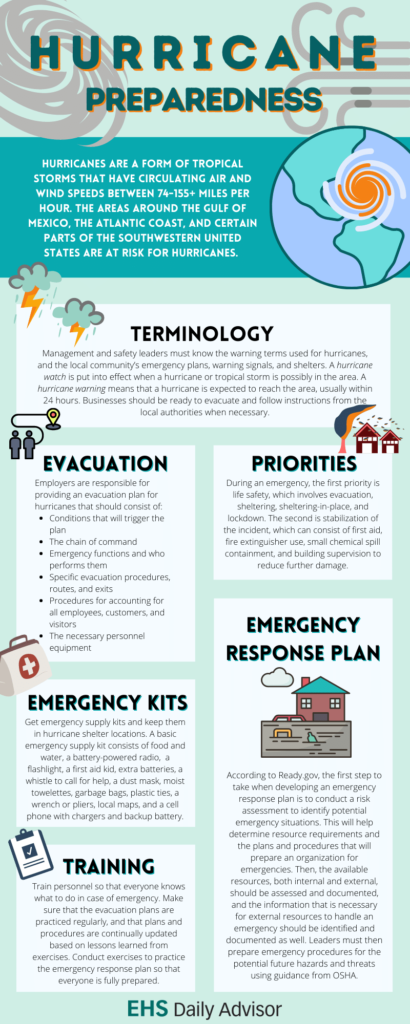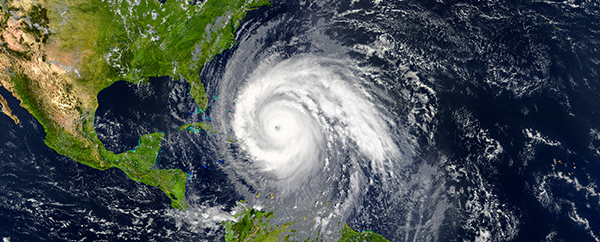Practical tips and strategies to protect your clients from hurricane damage
Prepare your clients for hurricane season by encouraging them to follow these steps:
- Review and update emergency plans: Ensure your clients have comprehensive plans tailored to help them withstand and quickly recover from hurricane damage.
- Protect people, product and property: Advise clients to establish a robust communication system; secure critical equipment and data; and reinforce their buildings to minimize loss.
- Stay informed and prepared: Emphasize the importance of monitoring weather alerts, preparing emergency supply kits, conducting regular emergency training and reviewing insurance coverage for adequate protection.
Hurricane season is in full swing, and according to the National Oceanic and Atmospheric Administration, we can expect above-normal activity this year. Have you advised your clients to review and update their emergency action plans yet? Doing so could help ensure their business can withstand and quickly recover from potential storm damage.
Although it’s still particularly crucial for businesses along hurricane hotbeds to be prepared, warming oceans are causing storms to grow increasingly intense and move further inland; Hurricane Beryl is proof that the threat now extends beyond traditional coastal regions. So, with rapidly changing climate patterns, it’s vital for businesses to abandon the ‘it-won’t-happen-here’ mentality and establish comprehensive emergency action and evacuation plans, as well as procedures for recovering from storm damage. Being prepared is more important than ever and now is the time do it, so let’s dive into what your clients can do to increase the chances their businesses will literally and figuratively weather the storm.
Related: Safety tips for business recovery after a hurricane or other disaster
Critical steps to protect your clients from hurricane damage
It shouldn’t go without saying that every business’ first priority should be to protect its workforce, but beyond that, there are several critical steps your clients can take to protect their business from a hurricane making landfall in their area.
Protect people
Workforces are now more dispersed than ever, with some employees working onsite, others remotely and some holding roles that require constant travel. Thus, it’s crucial to implement a robust communication plan to protect the well-being of all employees during a hurricane. More specifically:
- Have HR keep track of where each employee typically works and their travel schedule
- Create a mass notification system for quick communication and establish a system to account for all employees, customers and visitors during an emergency
- Develop an evacuation plan that includes all exits, stairs, elevators, parking lots and access to the nearest evacuation route
- Ensure you have an updated list of emergency contacts
Protect property
Your clients should also take proactive measures to reinforce buildings and minimize physical damage from high winds and flooding. They should consider doing the following:
- Keep an up-to-date list of what is on premise, including inventory
- Install shutters or plywood to protect windows and doors from debris
- Evaluate the building’s roof to ensure it can withstand a storm
- Trim branches and remove nearby trees that could potentially fall and cause damage
- Secure all outdoor equipment and anchor large furniture to wall studs
- Sandbag areas subject to flooding
- If possible, turn off all utilities prior to a hurricane making landfall
Related: Protecting your home after a hurricane or major storm
Protect important data and documents
Of course, it’s also imperative to protect critical data and documents to ensure they’re quickly recoverable after a storm. Some action items include:
- Storing essential documents, such as insurance policies, legal contracts and tax returns, in waterproof containers and when possible, maintaining digital copies to prevent loss due to water damage
- Ensuring digital data is backed up regularly and stored in an off-site secure facility
Preparedness plan
And no business should skip developing detailed emergency response plans tailored to their specific needs. The plans should include:
- All of the above
- Clear procedures for different emergency scenarios, including the conditions that activate the plan and the roles and responsibilities of each employee
- Business continuity plans to minimize disruptions during and after a hurricane, such as setting up backup generators or temporarily moving operations to another location
- A schedule for regular training and drills to ensure all employees are prepared and the plan can be updated based on lessons learned during these exercises
Additional tips for hurricane preparedness
Overall, in the event of an emergency, the priority should always be on protecting people first, and property and product second. However, to better prepare for a hurricane, businesses should also:
- Monitor weather alerts: It’s always a good idea to stay informed about potential threats by monitoring weather alerts and heed warnings from the National Hurricane Center and other reliable sources. And to better understand the level of threat and necessary actions, encourage your clients to familiarize themselves with the difference between a hurricane “watch” and a “warning”.
- Stock emergency kits: Prepare emergency supplies for the workplace, including non-perishable food, water, first aid supplies, flashlights, batteries and communication devices. These kits should be easily accessible and maintained regularly.
- Review insurance policies: Now is the time to advise your clients to review their insurance policies to ensure they have adequate coverage for hurricane-related damages. They should understand the specifics of their coverage, identify any gaps and consider additional coverage, if necessary.
- After the storm: Encourage your clients to have policy information ready and as soon as conditions are safe, conduct an after-storm inventory. Quick remediation will be crucial to preventing further water damage and mold growth, but they should take care to work with licensed and reputable contractors to repair any damages.
Related: How you can help your clients recover after a hurricane
Unfortunately, increasingly intense tropical storms are the new reality, and it’s clear that no one is immune to their path of destruction. It truly is more important than ever to increase business resilience against hurricanes and other extreme weather events by following these steps and continually improving preparedness strategies. So don’t delay; share this information with your clients and help them increase their chances of weathering any storm that comes their way.
To help quickly convey this information to your clients, review the infographic — used with permission from EHS Daily Advisor — below.

For more information on protecting a business from hurricane damage, download FEMA’s Business Toolkit.
References:
Hurricane preparedness is increasingly crucial for businesses (propertycasualty360.com)
5 steps to boost storm resilience as hurricane season begins (propertycasualty360.com)
Back to Basics: Are You Prepared for Hurricane Season? – EHS Daily Advisor (blr.com)

